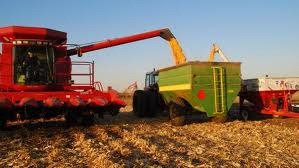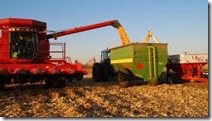MANHATTAN, Kan. – Much of the dryland corn crop currently being harvested in southeast and south central Kansas has been subjected to severe drought stress during a good portion of the growing season, said Kraig Roozeboom, K-State Research and Extension crop production specialist. Under these conditions, harvest may present some challenges.
“Where corn has been under drought stress, there is increased likelihood for stalk lodging and dropped ears, among other concerns. In this situation, it is especially important that corn is harvested in a timely manner and with a well-adjusted combine,” Roozeboom said.
Droughty conditions, especially during grain fill, can predispose corn to a number of stalk rots, which in turn may result in stalk lodging, said Doug Jardine, K-State Research and Extension plant pathologist.
“Stalk lodging in corn occurs when the stalk weakens and breaks at some point below the ear. We often find stalk rot disease organisms – such as charcoal rot, Fusarium,Gibberella, anthracnose, and others — on corn with stalk lodging,” Jardine said.
Although stalk rot is often the ultimate cause of lodging, in most cases, the stalk rot diseases were only able to infect the plants because other factors predisposed the plants to disease infection, he said. Such factors include:
* Hybrid differences in stalk strength or stalk rot susceptibility. Some hybrids have genetically stronger stalks than others.
* Poor root growth and other stresses. Cold, waterlogged soils early in the season; severe drought; and soil compaction all can result in small, inadequate root systems. In such cases, the roots may not provide enough water and nutrients to support carbohydrate production. When carbohydrate production is below normal during any part of the growing season, the ears will continue to take what they need during grain fill, which can leave the stalks depleted even under average yield conditions.
* Poor leaf health. Any factor that results in poor leaf health will reduce carbohydrate production during the season. If overall carbohydrate reserves in the plants are low when grain fill begins, stalk integrity may suffer as the available supply of carbohydrates moves into grain production. Stay green characteristics in hybrids are highly correlated to stalk rot resistance and reduced lodging.
* High populations. Plants can become tall and thin when populations are too high, which can result in thin stalks with inadequate strength. Plant-to-plant competition for light, nutrients, and water enhances the competition for carbohydrates between the stalk and ear within the plant, thus reducing the vigor of the cells in the stalk and predisposing them to invasion by stalk rot.
* Nutrient imbalances and/or deficiencies predispose corn plants to stalk rot and stalk lodging. Both potassium and chloride deficiency have been shown to reduce stalk quality and strength, and stalk rot resistance. High nitrogen levels coupled with low potassium levels increase the amount of premature stalk death, and create an ideal situation for stalk rot and lodging. Soil chloride levels should be maintained above 20 pounds per acre.
* Corn rootworm and corn borers. Damage caused by corn rootworm and the European corn borer can predispose the corn plant to invasion by stalk rotting organisms, as well as lead to outright yield loss.
* Mid-season hail damage. Similar to the damage caused by insects, the physical damage caused by mid-season hail can set up the plant for invasion by stalk rotting organisms. Stalk bruising and the resulting internal damage may also physically weaken corn stalks, making them more likely to lodge later in the season.
Ear drop is another concern where corn has been under drought stress, Jardine said.
“The ear shank (stem that attaches the cob to the stalk) may not develop normally in stressed conditions,” he said. “Also, rapid drydown may result in brittle tissue where the ear attaches.”
A “pinched shank” or constriction on one side of the shank may occur in some cases, he added. “This is usually associated with missing kernels at the base of the ear on the same side as the pinch,” he said.
With these problems, there can be hybrid differences, Jardine said. Some hybrids may have a smaller-diameter shank attachment.
Ear drop may also be due to disease organisms, he added.
“Fusarium stalk rot (pink stalk rot) may infect the ear shank, causing deterioration of the tissues and greater numbers of dropped ears,” Jardine said.
Other concerns with drought-damaged corn include low test weights and aflatoxin, Roozeboom said.
If aflatoxin levels are high, storage may be a concern, Jardine said.
“Aflatoxin levels may increase in storage if the corn is held very long at moisture levels above 14 percent,” he added. “Growers intending storage for more than a week or two should have their corn tested for aflatoxin. Corn testing above 100 parts per billion should probably not be stored long-term.”


Deprecated: strpos(): Passing null to parameter #1 ($haystack) of type string is deprecated in /home/agriviek8Qv/agriviet.net/public_html/wp-includes/comment-template.php on line 2522